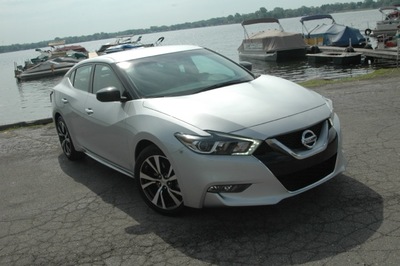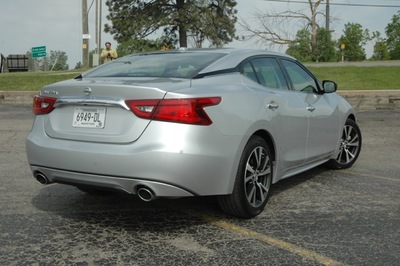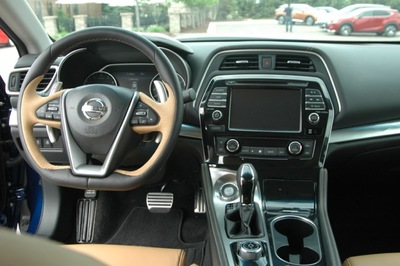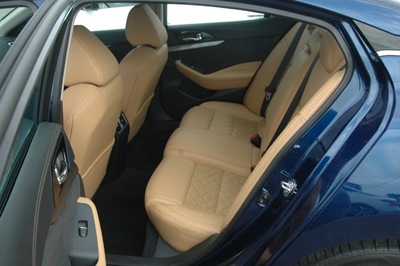2016 Nissan Maxima SR Review By Steve Purdy
2016 NISSAN MAXIMA
Review By Steve Purdy
Senior Editor
The Auto Channel
Michigan Bureau
Nissan introduced the newest version of their Maxima full-size sedan - the eighth generation of the longest running nameplate since its introduction in 1981 - just last summer. Thinking back to 1981 (Yes, I am old enough to have been around and paying attention to cars in those difficult days in the auto industry), it was a time of truly dismal cars from U.S. automakers and a time when Asian brands were making increasingly strong inroads into the U.S. market beginning with little economy cars and eventually branching out into just about every automotive category.
Even in those early days Nissan billed the Maxima as the sportiest of mainstream sedans (excluding the Europeans) with some justification. In fact, if I’m not mistaken, Nissan was the last to offer a manual transmission in their biggest sedan. They continue to refer to the new Maxima as 4DSC (4-Door Sport Car) with subtle badging to tout that claim. While it sounds just a bit hyperbolic, after a week with the car I’m inclined to go along with the claim.
“Energetic Flow” is the moniker for Nissan’s new design language already defining Murano and other products. With the Maxima they have incorporated the visually interesting floating roof that hints at a lower, wider profile and provides a modern aura. In fact, it is actually is a tad lower and wider than the outgoing model. More dramatic front and rear fascia brings the look significantly more upscale and trendy with lots of brashness up front. Boomerang-shaped LED lighting front and rear help Maxima keep up with trends as do exaggerated wheel arches.
Inside we see a higher console and center stack turned more toward the driver. Way more techie details went into the large multi-purpose screen and instrument cluster including a “punch and swipe” function to move information between screens. A controller augments management of the 8-inch multifunction screen. Interior volume did not increase much leaving it among the smallest of the full-size sedans, though that is not apparent when you’re in the car. A wide console houses the start button (standard), the shifter and cup holders. The “zero-gravity” seats are well bolstered and comfortable. A door and deep bin at the base of the center stack hides two USB ports and an auxiliary input.
Nissan designers say they were trying to emulate a fighter jet cockpit. Frankly, I don’t see that, but I find it considerably more attractive, stylish luxurious than the outgoing model. Lots of contrasting stitching and an unusual diamond-patterned dash trim fits with the upscale aspirations of the Maxima.
Engine updates include “61% new parts,” they claim, adding 10 more horsepower, best combined fuel mileage in the class at 25 mpg and best horsepower/liter calculation at 86. Maxima now boasts 300 horsepower and 261 pound-feet of torque. New engine stuff includes piston surfacing and rings, sodium-filled valves, new head design and other details we’ll never see but make this ubiquitous, normally-aspirated, 3.5-liter V6 more efficient and durable.
The engine feels strong enough to compete well with the competition but what surprised me more was the sophistication of that improved CVT. Nissan led the industry in the use of continuously variable transmissions and early versions felt wheezy and cheesy. But this one has a broader ratio range, shift points programmed in and it adjusts to your driving style. It sort of reads between the lines on throttle input. The ”Sport” mode, included on all models, adds more dynamic inputs for a sportier feel. No matter how biased I’ve become against them, I can’t find anything to complain about with this CVT.
All-wheel drive is not offered.
The chassis of the revised Maxima is 25% more rigid and just a bit lighter because of the generous use of high-strength steel. More stiffness means more precise feel on the road, and it did feel very stable and firm. Suspension is improved with mono-tube shocks and improved calibration.
Maxima is put together in Nissan’s massive Smyrna, TN assembly plant that produces well over 600,000 cars/year including Rogue, Pathfinder, Altima, Infiniti QX60 and Leaf. Fit, finish and materials will compare well with anything in the market. They’re doing a great job in Smyrna.
The acoustic engineers earned their pay with this car. Not only have they damped the unpleasant sounds with noise cancelation technology but they have also found a way to direct pleasant engine noises into the cabin to make it seem even sportier. We found road and other unpleasant noise levels impressively low.
Nissan has taken a new approach to marketing the Maxima. They are offering 5 models, or trim levels, but no stand-alone options. The bottom-end S model starts at $32,410 and the top-end Platinum starts at $39,860. If you averaged out prices of comparable cars from the current Maxima line the new pricing represents an increase in price of about $850. The top-level-but-one, the “SR” is the sportiest of the bunch. We think it offers an impressive balance of luxury and sport.
The competition in this class is intense and filled with high-quality products like Impala and Avalon, and the older but still good LeCrosse, Taurus, Kia Cadenza, Hyundai Azera and Chrysler 300. While the Maxima is a “full-size” sedan according to most definitions Nissan likes to compare it to smaller, more sporty cars like the 3-Series BMW, Acura TLX, Audi A4 and Lexus IS. They will focus marketing on a demographic they think of as “luxury intenders, ” according to the marketing folks.
Our test car is the SR model showing a starting price of $37,670. Only floor mats, trunk mat and truck net show as extras. With the $825 destination charge our sticker shows $38,750 on the bottom line. Lots of premium content gets included in that price: 19-inch alloy wheels, sport suspension, LED low beams and DRLs, high-end heated and cooled (in front) leather seats with Alcantara (synthetic suede) inserts, paddle shifters, aluminum pedals, classy ambient lighting, adaptive cruise control, 8-inch display with navigation and NissanConnect, voice recognition, remote start (ours only worked intermittently), sport D-shaped steering wheel with Alcantara trim, heated steering wheel, Bose premium sound, active sound cancellation and enhancement, dual-zone HVAC and push button start.
The base S model starts at $32,510, has the same powertrain and is quite well equipped as well.
This powertrain is sweet. With gobs of power and great sound it’s fun to put your foot in it even with the CVT’s idiosyncratic acceleration. Our friends at Edmunds recorded an impressive 0-to-60 mph time of just 6.2 seconds. Handling is crisp and suspension is calibrated on the firm side of the spectrum. We found no conditions where it was unpleasantly stiff and we have some rather coarse roads around here, particularly in the spring when we reviewed this car.
The EPA estimates you should get 22 mpg in the city, 30 on the highway and 25 mpg combined. We managed 25.1 this week with some rather spirited driving in our rural and suburban environs. Well done Nissan!
I’m usually skeptical of marketing hyperbole but I’ll give credit where credit is due – the new Maxima, at least in this sportiest SR trim level, earns its 4-Door Sports Car moniker.
ęSteve Purdy, Shunpiker Productions, All Rights Reserved
The Most Nissan Vehicle Research Information Anywhere!






